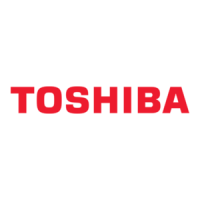
Do you have a question about the Toshiba Semiconductor and is the answer not in the manual?
| Brand | Toshiba |
|---|---|
| Model | Semiconductor |
| Category | Semiconductors |
| Language | English |
General safety precautions for handling semiconductor devices.
Precautions from receiving devices to shipping them.
Protecting devices from electrostatic discharge during handling.
Handling devices carefully to prevent damage from vibration, impact, and stress.
Guidelines for proper storage of semiconductor devices.
General recommendations for storing devices to prevent degradation.
Understanding and adhering to absolute maximum ratings for device safety.
Operating conditions necessary to guarantee device performance.
Minimizing thermal stress by reducing rated maximum voltage, current, and temperature.
Handling input signals for CMOS ICs to prevent malfunctions.
Connecting inputs to a printed circuit board to avoid electrical floating.
Designing power sources for CMOS ICs to ensure stable operation.
Managing input signal rise and fall times to prevent oscillations and breakdown.
Preventing damage from output short circuits in C2MOSTM ICs.
Correctly connecting capacitors to signal lines or power/ground.
Precautions for wiring to prevent waveform distortion and noise.
Understanding and preventing latch-up conditions in CMOS devices.
Handling electrical discharge and protecting devices from noise.
Understanding and solving meta-stability issues in flip-flops.
Designing for thermal management to ensure device reliability and longevity.
Matching input/output voltages and handling supply voltage differences.
Protecting circuit boards from induced noise and surges.
Understanding and mitigating electromagnetic interference (EMI) effects.
Matching input/output voltages and considering drive capability.
Adhering to country-specific safety standards for device insulation and quality.
General precautions including fail-safe design and avoiding conductive objects.
Procedures for inspecting, testing, and evaluating semiconductor devices.
Importance of grounding measuring instruments, jigs, and soldering irons.
Steps to follow during inspection and testing, including orientation and power.
Methods and precautions for mounting semiconductor devices on PCBs.
Proper techniques for forming device leads to prevent stress and damage.
Precautions for using sockets when mounting devices.
Recommended temperature profiles for soldering using irons and reflow methods.
Procedures and precautions for cleaning circuit boards after flux.
When cleaning is not required for devices with low halogen flux.
Considerations for coating circuit boards for protection in extreme environments.
Methods to protect semiconductor devices from environmental factors.
Understanding temperature effects on device characteristics and reliability.
Managing humidity levels to prevent degradation and ESD.
Protecting devices from degradation caused by corrosive gases.
Shielding requirements for devices in radioactive environments.
Protecting devices from strong electrical and magnetic fields.
Protecting devices from malfunction caused by light exposure.
Avoiding dusty or oily environments to prevent device degradation.
Safety precautions regarding combustible semiconductor devices.
Procedures for environmentally responsible disposal of devices and materials.
